Interdependencies of Infrastructure Investment Decisions in Multi-Energy Systems—A Sensitivity Analysis for Urban Residential Areas
Abstract
:1. Introduction
- What are the building-, heating-, and grid-specific factors that influence significant changes in the energy supply infrastructure, such as gas grid defection?
- How are these building-, heating-, and grid-specific influencing factors pronounced in real urban grid areas?
- How are the endogenous variables (gas demand, gas grid charges) shaped within the transformation path and influenced by different configurations of the exogenous variables (building type and age, heating system configuration, grid topology)?
- Which configuration of exogenous factors (building type and age, heating system configuration, grid topology) results in an equilibrium between the construction and replacement of gas-based heating systems, fosters gas-based systems, or leads to the collapse of the gas grid infrastructure?
2. Materials and Methods
2.1. Research Approach
2.2. Building Energy Retrofit Model
2.2.1. Optimization Problem
2.2.2. Objective Function
- : The investment expenditure for the building envelope retrofit (Equation (3)) is a function of the insulation thickness and the building surface area , which is calculated based on the different surface parts 𝓅 [22]. The building surface is modeled in a single zone. The design-relevant heat load is calculated based on DIN EN 12,831 (German and European harmonized standard) [37]. The optimizer can choose an additional insulation between 0 and 30 cm. The cost parameters and are calculated individually for every building based on the area ratios of the individual surface parts and the corresponding costs [38]: roof, facade, windows, floor, and door.
- : The investment expenditure for the building energy system (Equation (4)) is a function of the building heat load and the size of the solar thermal plant [22]. represents the design-relevant heat load [37], including transmission and ventilation losses. The available heating systems are an air water heat pump (AWHP), a gas condensing boiler (GCB), an oil condensing boiler (OCB), a pellet burner (PB), and an electrical direct heating (EDH). and are the corresponding specific cost parameters. Additionally, the optimizer is able to install a solar thermal system (STE) and lower the heating circuit temperature to increase the efficiency. and are the corresponding specific cost parameters (STE).
- : The expenditure for energy procurement (Equation (5)) is a function of the building heat load , the domestic hot water demand the size of the solar thermal plant , and the additional wins and losses , as well as the plant expenditure figure , the yearly usage hours , the costs for energy procurement in the year of investment , and the present value factor for energy procurement [22]. The additional heat losses and wins include heat distribution losses, auxiliary energy, radiation losses, and internal wins [39,40]. They are not affected by the retrofit. The specific cost parameter is calculated based on the energy procurement price , tax , and grid charges .
- : The operation expenditure for the maintenance of the building energy system (Equation (6)) is determined based on a fixed yearly rate dependent on the heating system and solar thermal plant type and size ( and ), as well as the present value factor for maintenance [22].
2.2.3. Constraints and Parameter Setting
- Can choose a building surface insulation measure,
- Has to replace the heating system, and
- Can choose a solar thermal plant.
- Regulatory energy efficiency constraint: We limit the yearly CO2 emissions and the final energy demand to an upper bound of the initial demand . Additionally, we constrain the yearly primary energy demand to , which is a demand that is calculated based on the energy-efficiency targets of the energy-saving ordinance of Germany [41].
- Retrofit rate of building envelope and heating system: The literature covers renovation rates of about 3.3% for heating systems and about 2–3% for building envelope retrofits. This corresponds to a technical lifetime of the heating system of about 30 years and of the surface of about 40–50 years [42]. We set the date of investment of each building in order to reach this heating retrofit rate (approximately 3%). Additionally, we oblige 66% of buildings to retrofit their envelope and heating system; this corresponds to an envelope retrofit ratio of approximately 2%.
- Taxation and levy systems: We calculate the levies and taxes with regard to the current energy prices in Germany and grid charges in the city area of Bamberg. In addition, we use a CO2 price, which will increase from 25 €/t in 2019 to 65 €/t in 2026 [43].
- Grid charge models: We reduce the electricity grid charges for heat pumps and electrical heatings down to 25% of their regular value, due to the German law [44].
2.3. Distribution Network Operator Model
2.3.1. Supply Task: Relationship between Energy Supplied, Customer Number, and Grid Length
2.3.2. Distribution Network Operator’s Investment Decisions
2.3.3. Integration of the DNO into the Building Model
- Upper and lower limits for the grid charges: The grid charges are limited downwards (0 €) as well as upwards (100 €).
2.4. Procedure for the Analysis of Transformation Paths
2.5. Conception of the Sensitivity Analysis
2.6. Grid and Building Data and Software Tools
3. Results and Discussion
3.1. Identification of Influencing Parameters
3.2. Analysis of Selected Structural Parameters for Real Urban Grid Areas
- The number of customers supplied as well as the network length serve to classify the size of the investigated grid gas and electricity areas;
- The energy demand and the number of customers per meter of line are used to classify the demand or customer density;
- The average annual energy consumption of buildings provides information on the average customer size; the exponent k describes the grid topology and serves as a measurand for the relationship between the number of customers and the grid length needed for supply. This is the median of 10,000 simulations in which the customers are randomly removed from the grid one after the other. During this procedure, we have classified the grid length needed for supply and finally performed a power function fit to estimate k for every grid (n = 58) and simulation (n = 10,000) [16].
3.3. Model Validation and Transformation Path Analysis of a Real Grid Area
- Electric direct heatings are substituted without exception due to the energy price and the regulatory constraints, mainly by electric heat pumps (25 out of 26 systems in [22]).
- Measures in the range of 10–20 cm are chosen for building insulation. In those cases, oil and gas burners (84% of the buildings with insulation measures in [22]) become more attractive than heat pumps (16%).
- Solar thermal systems are only installed in a small number (n = 6) and mainly used in apartment buildings (four out of six buildings in [22]).
3.4. Sensitivity Analysis for Types of Building Areas
- The initial length-weighted grid age has a major impact on the level of the grid charges. It largely determines the DNO’s CAPEX, which is dependent on the grid length and age. We vary the base setup (electricity and gas grid age of ) to a grid age of .
- The building owners’ investment decisions are significantly influenced by the level of the interest rate for energy procurement expenditure. We model them as an annually constant expenditure series for the technical lifetime of the heating system (33.5 years) and an interest rate of 4% (PF = 18.3). We vary the rate of the base setup to a rate of 0.5% (PF = 31).
4. Conclusions
Author Contributions
Funding
Acknowledgments
Conflicts of Interest
Appendix A. Nomenclature
| Acronym | Name | Acronym | Name |
|---|---|---|---|
| AWHP | Air water heat pump | MPPDC | Mathematical program with primal and dual constraints |
| BES | Building energy system | MAS | Multi-agent simulation |
| BE | Building envelope | MFH | More family house |
| B | Building age class | MSE | Mean squared error |
| BO | Building owner | OCB | Oil condensing boiler |
| CAPEX | CAPEX | OPEX | OPEX |
| CO2 | Carbon dioxide | OSM | Open street maps |
| COP | Coefficient of performance (heat pumps) | PB | Pellet burner |
| DHW | Domestic hot water | PF | Present value factor |
| DNO | Distribution network operator | R2 | Coefficient of determination |
| E | Energy | RFA | Reference floor area |
| EDH | Electrical direct heating | RBV | Rest book value |
| ERR | Expected rate of return | RC | Revenues cap |
| EU | European Union | STE | Solar thermal plant |
| GC | Grid charges | SFH | Single family house |
| GCB | Gas condensing boiler | SGC | Stable grid charges |
| GWHP | Ground water heat pump | SGV | Stable grid value |
| IQD | Interquartile distance | SRC | Stable revenue cap |
| IWU | Institute Housing and Environment | STE | Solar thermal energy plant |
| MILP | Mixed integer linear program | TH | Terraced house |
| Parameter | Description [Unit] | Value | Source | |
|---|---|---|---|---|
| Components of the expenditures | ||||
| Total expenditures for heating within the technical lifetime of the heating system [€] | ||||
| Investment expenditures for the building insulation retrofit [€] | ||||
| Investment expenditures for the change of the heating system and technical building equipment [€] | ||||
| Expenditures for energy procurement over the technical lifetime of the heating system [€] | ||||
| Expenditures for maintenance over the technical lifetime of the heating system [€] | ||||
| Parameters | ||||
| Building surface area [m2] | Corresponding values are shown in [22] (Supplementary Materials) | |||
| Area of a building surface component [m2] | ||||
| Yearly usage hours of the heating system [h] | ||||
| Design-relevant building heat load (for heating system) (thermal ventilation and transmission losses) [kW] | ||||
| Heat load for: Radiation losses, internal wins, heat distribution losses, auxiliary energy [kW] | ||||
| Heat load thermal solar plant [kW] | ||||
| Heat load for domestic hot water generation [kW] | ||||
| Specific yearly expenditures for maintenance of the heating in percent of investment expenditure [-] | ||||
| Specific yearly expenditures for maintenance for the solar thermal plant in percent of investment expenditure [-] | ||||
| Plant expenditure figure of the heating systems | ||||
| Energy carrier of the heating system (Binary decision parameter) | ||||
| Specific variable investment expenditures for a building surface retrofit [€/(m2·cm)] | ||||
| Specific fix investment expenditures for a building surface retrofit [€/m2] | ||||
| Insulation thickness [cm] | 0–30 | |||
| Specific variable expenditures for the heating system [€/kW] | Corresponding values are shown in [22] (Supplementary Materials) | |||
| Specific fix expenditures for the heating system (maintenance) [€] | ||||
| Specific fix expenditures for the heating system [€] | ||||
| Specific variable expenditures for the solar thermal plant [€/kW] | ||||
| Specific fix expenditures for the solar thermal plant [€] | ||||
| Specific yearly energy related expenditures (tax + procurement + grid charges) [€/kWh] | ||||
| Specific energy procurement costs | Electricity [€/kWh] | 0.0761 | [78] | |
| Natural gas [€/kWh] | 0.0313 | [78] | ||
| Oil [€/l] | 0.506 | [79] | ||
| Pellet [€/kg] | 0.231 | [80] | ||
| Energy related taxes and duties (excluding the CO2 tax, which is calculated in the model) | Electricity [€/kWh] | 0.1602 | [78] | |
| Natural gas [€/kWh] | 0.0164 | [78] | ||
| Oil [€/l] | 0.169 | [81,82] | ||
| Pellet [€/kg] | 0.016 | [81,82] | ||
| Specific CO2-emissions per energy carrier [kg/kWh] | Electricity (linear decrease to 0.103 in 2050) | 0.462 | [83,84] | |
| Natural gas | 0.202 | |||
| Oil | 0.294 | |||
| Pellet | 0.023 | |||
| Heating value | Natural gas [kWh/m3] | 11.42 | [85] | |
| Oil [kWh/liter] | 11.27 | |||
| Pellet [kWh/kg] | 5.27 | [86] | ||
| Primary energy factor | Electricity | 1.8 | [19] | |
| Natural gas | 1.1 | |||
| Oil | 1.1 | |||
| Pellets | 0.2 | |||
| Initial yearly end energy demand of a building | ||||
| Initial yearly CO2 emissions of a building | ||||
| Upper bound for the yearly primary energy demand considering the energy efficiency constraint | ||||
| Upper bound for the heat load considering the energy efficiency constraint | ||||
| Present-value factor maintenance | 31 | |||
| Present-value factor energy procurement | 31 or 18.3 | |||
| Variables | ||||
| Building surface retrofit 𝒹 in house 𝒿 (Binary decision variable) | ||||
| Heating system 𝓀 in house 𝒿 (Binary decision variable) | ||||
| Solar thermal plant 𝓈 in house 𝒿 (Binary decision variable) | ||||
| Energy for heating applications in year 𝓉 in gas or electricity grid [kWh/a] | ||||
| Energy for all applications except heating in year 𝓉 in gas or electricity grid [kWh/a] | ||||
| Grid charges gas or electricity in year 𝓉 [€/kWh] | ||||
| Indices and sets | ||||
| An insulation thickness standard 𝒹 of all standards | ||||
| Surface part 𝓅 of all building surface parts | ||||
| . | A heating system type 𝓀 of all heating system types | |||
| An energy carrier 𝒸 of all carriers | ||||
| A solar thermal plant 𝓈 of all available types and sizes | ||||
| A building 𝒿 of all buildings connected to the grid | ||||
| Parameter | Description [Unit] | Value | Source | |
|---|---|---|---|---|
| Gas | Electricity | |||
| Cost components of the revenue cap | ||||
| Capital expenditures gas or electricity [€] | ||||
| Operational expenditures gas or electricity [€] | ||||
| Calculated return on equity gas or electricity [€] | ||||
| Interest on borrowed capital gas or electricity [€] | ||||
| Calculated trade tax gas or electricity [€] | ||||
| Calculated interest on borrowed capital gas or electricity [€] | ||||
| Operational costs gas or electricity [€] | ||||
| Loss costs gas or electricity [€] | ||||
| Upstream grid charges gas or electricity [€] | ||||
| Concession fees gas or electricity [€] | ||||
| Parameters | ||||
| Interest rate equity capital of line ℓ | 0.0691 * | 0.0691 * | ||
| Amount of equity capital of line ℓ | 0.40 | 0.40 | [17] | |
| Interest rate borrowed capital of line ℓ | 0.035 * | 0.035 * | ||
| Amount of borrowed capital of line ℓ | 0.60 | 0.60 | [17] | |
| Trade tax rate | 0.14 * | 0.14 * | ||
| Technical lifetime of a line [a] | 45 | 40 | [87] | |
| Planning horizon [a] | 31 | 31 | ||
| Specific costs of upstream grid charges [€/kWh] | 0.0030 * | 0.025 * | ||
| Specific costs for concession fees [€/kWh] | 0.0023 * | 0.011 * | ||
| Specific lost costs [€/kWh] | 0.0080 * | 0.044 * | ||
| Loss factor | 0.00 * | 0.026 * | ||
| Specific operational costs [€/m] | 5.0 * | 7.9 * | ||
| Any other energy in year 𝓉 in gas or electricity grid [kWh/a] (calculated based on the RFA) | 0 * [kWh/(m2·a)] | 25 * [kWh/(m2·a)] | ||
| Variables | ||||
| Line age at the begin of planning horizon [a] * | ||||
| Technical lifetime of a grid line ℓ [a] | ||||
| Historical acquisition expenditures for line ℓ [€/m] * | ||||
| Line length of line ℓ [m] * | ||||
| Line length of a grid in the year 𝓉 [m] * | ||||
| Maximal line length of a grid, when every building is connected to the grid [m] | ||||
| Number of grid customers in year 𝓉 | ||||
| Maximal number of grid customers, when every building is connected to the grid | ||||
| Length-weighted average age of the grid [a] | ||||
| Rest book value factor of line ℓ in year 𝓉 as a function of the binary decision variables | ||||
| Mean rest book value factor of all grid asset in year 𝓉 | ||||
| Grid charges gas or electricity in year 𝓉 [€/kWh] | ||||
| Energy for heating applications in year 𝓉 in gas or electricity grid [kWh/a] | ||||
| Indices and sets | ||||
| A building 𝒿 of all buildings connected to the grid | ||||
| A line ℓ of all lines in the grid | ||||
| A year 𝓉 within the planning horizon | ||||
| An energy carrier 𝒸 of all carriers | ||||
| Investment expenditure for new construction of grid assets | ||||
| Investment expenditures electrical lines [€/m] | 114 * | |||
| Investment expenditures gas pipes [€/m] | 214 * | |||
Appendix B. Building Retrofit Optimization Model
- Original paper: Detailed description and primary sources of the building retrofit optimization model and constraints
- Supplements part: Thermal building model—calculation of the building heat load
- Supplements part: Thermal building model—domestic hot water generation and additional heat losses and wins
- Supplements part: Solar thermal model
- Supplements part: Building surface model—calculation of specific building surface investment expenditures and heat transmission coefficients
- Supplements part: Preprocessing procedure for the calculation of the building individual investment expenditures for the heating system
Appendix C. Conception of the Sensitivity Analysis and Transformation Path Analysis
- Specific investment expenditures per building surface parts
- Specific investment expenditures for the technical building equipment options
- Technical specifications of the building heating systems (retrofit)
- Technical specifications of the solar thermal plants (retrofit)
- Initial building properties of the used building types
- Initial building heating system types and specifications
- Initial heat transmission coefficients and areas of the building surface parts
- Validation: We limit the solution space by reducing the number of possible insulation thicknesses (0, 10, 15, 20 cm) and that of the solar thermal systems (0, 60%, 100% coverage rate for drinking water), with the goal of reducing the calculation time.
- Sensitivity analysis: We limit the solution space by reducing the number of possible insulation thicknesses (0, 5, 10, 15, 20, 25, 30 cm) and that of the solar thermal systems (0, 20%, 40%, 60%, 80%, 100% coverage rate for drinking water), with the goal of reducing the calculation time.
- Validation: We set the parameters and constraints of the simulation corresponding to [22]: Investment dates, building and heating system types are set according to seed 1; Grid length is set corresponding to seed 1; Constraints are set according to “Combination 2”; Parameters of the electricity and gas grid as well as the building and heating system.
- Validation and sensitivity analysis: We set reduced grid charges (25%) for interruptible consumers in the electricity sector (storage heaters and heat pumps), which causes revenue shortfalls for the DNO. In reality, these shortfalls are passed on to the regular grid charges. Due to the size of the investigated grid areas, this would cause unrealistic high grid charges. In this way, we do not implement this levy mechanism.
| Connection Ratio Gas Grid | Building Age | Heating System | Year of Investment | ||||||||||||||||||||||||||||||
|---|---|---|---|---|---|---|---|---|---|---|---|---|---|---|---|---|---|---|---|---|---|---|---|---|---|---|---|---|---|---|---|---|---|
| 0 | 1 | 2 | 3 | 4 | 5 | 6 | 7 | 8 | 9 | 10 | 11 | 12 | 13 | 14 | 15 | 16 | 17 | 18 | 19 | 20 | 21 | 22 | 23 | 24 | 25 | 26 | 27 | 28 | 29 | 30 | |||
| 1 | B | AWHP | |||||||||||||||||||||||||||||||
| GCB | 1 | 1 | 1 | 1 | 1 | 1 | 1 | 1 | 1 | 1 | 1 | 1 | 1 | 1 | 1 | 1 | 1 | 1 | 1 | 1 | 1 | 1 | 1 | 1 | 1 | 1 | 1 | 1 | 1 | 1 | 1 | ||
| OCB | |||||||||||||||||||||||||||||||||
| PB | |||||||||||||||||||||||||||||||||
| EDH | |||||||||||||||||||||||||||||||||
| 0.75 | AWHP | ||||||||||||||||||||||||||||||||
| GCB | 1 | 1 | 1 | 1 | 1 | 1 | 1 | 1 | 1 | 1 | 1 | 1 | 1 | 1 | 1 | 1 | 1 | 1 | 1 | 1 | 1 | 1 | 1 | ||||||||||
| OCB | 1 | 1 | 1 | ||||||||||||||||||||||||||||||
| PB | |||||||||||||||||||||||||||||||||
| EDH | 1 | 1 | 1 | 1 | 1 | ||||||||||||||||||||||||||||
| 0.5 | AWHP | ||||||||||||||||||||||||||||||||
| GCB | 1 | 1 | 1 | 1 | 1 | 1 | 1 | 1 | 1 | 1 | 1 | 1 | 1 | 1 | 1 | 1 | |||||||||||||||||
| OCB | 1 | 1 | 1 | 1 | 1 | 1 | 1 | 1 | |||||||||||||||||||||||||
| PB | |||||||||||||||||||||||||||||||||
| EDH | 1 | 1 | 1 | 1 | 1 | 1 | 1 | ||||||||||||||||||||||||||
| 1 | G | AWHP | |||||||||||||||||||||||||||||||
| GCB | 1 | 1 | 1 | 1 | 1 | 1 | 1 | 1 | 1 | 1 | 1 | 1 | 1 | 1 | 1 | 1 | 1 | 1 | 1 | 1 | 1 | 1 | 1 | 1 | 1 | 1 | 1 | 1 | 1 | 1 | 1 | ||
| OCB | |||||||||||||||||||||||||||||||||
| PB | |||||||||||||||||||||||||||||||||
| EDH | |||||||||||||||||||||||||||||||||
| 0.75 | AWHP | ||||||||||||||||||||||||||||||||
| GCB | 1 | 1 | 1 | 1 | 1 | 1 | 1 | 1 | 1 | 1 | 1 | 1 | 1 | 1 | 1 | 1 | 1 | 1 | 1 | 1 | 1 | 1 | 1 | ||||||||||
| OCB | 1 | 1 | 1 | ||||||||||||||||||||||||||||||
| PB | |||||||||||||||||||||||||||||||||
| EDH | 1 | 1 | 1 | 1 | 1 | ||||||||||||||||||||||||||||
| 0.5 | AWHP | ||||||||||||||||||||||||||||||||
| GCB | 1 | 1 | 1 | 1 | 1 | 1 | 1 | 1 | 1 | 1 | 1 | 1 | 1 | 1 | 1 | 1 | |||||||||||||||||
| OCB | 1 | 1 | 1 | 1 | 1 | 1 | 1 | 1 | |||||||||||||||||||||||||
| PB | |||||||||||||||||||||||||||||||||
| EDH | 1 | 1 | 1 | 1 | 1 | 1 | 1 | ||||||||||||||||||||||||||
| 1 | K | AWHP | |||||||||||||||||||||||||||||||
| GCB | 1 | 1 | 1 | 1 | 1 | 1 | 1 | 1 | 1 | 1 | 1 | 1 | 1 | 1 | 1 | 1 | 1 | 1 | 1 | 1 | 1 | 1 | 1 | 1 | 1 | 1 | 1 | 1 | 1 | 1 | 1 | ||
| OCB | |||||||||||||||||||||||||||||||||
| PB | |||||||||||||||||||||||||||||||||
| EDH | |||||||||||||||||||||||||||||||||
| 0.75 | AWHP | 1 | 1 | 1 | 1 | 1 | 1 | 1 | |||||||||||||||||||||||||
| GCB | 1 | 1 | 1 | 1 | 1 | 1 | 1 | 1 | 1 | 1 | 1 | 1 | 1 | 1 | 1 | 1 | 1 | 1 | 1 | 1 | 1 | 1 | 1 | 1 | |||||||||
| OCB | |||||||||||||||||||||||||||||||||
| PB | |||||||||||||||||||||||||||||||||
| EDH | |||||||||||||||||||||||||||||||||
| 0.5 | AWHP | 1 | 1 | 1 | 1 | 1 | 1 | 1 | 1 | 1 | 1 | 1 | 1 | 1 | 1 | 1 | |||||||||||||||||
| GCB | 1 | 1 | 1 | 1 | 1 | 1 | 1 | 1 | 1 | 1 | 1 | 1 | 1 | 1 | 1 | 1 | |||||||||||||||||
| OCB | |||||||||||||||||||||||||||||||||
| PB | |||||||||||||||||||||||||||||||||
| EDH | |||||||||||||||||||||||||||||||||
Appendix D. Additional Results
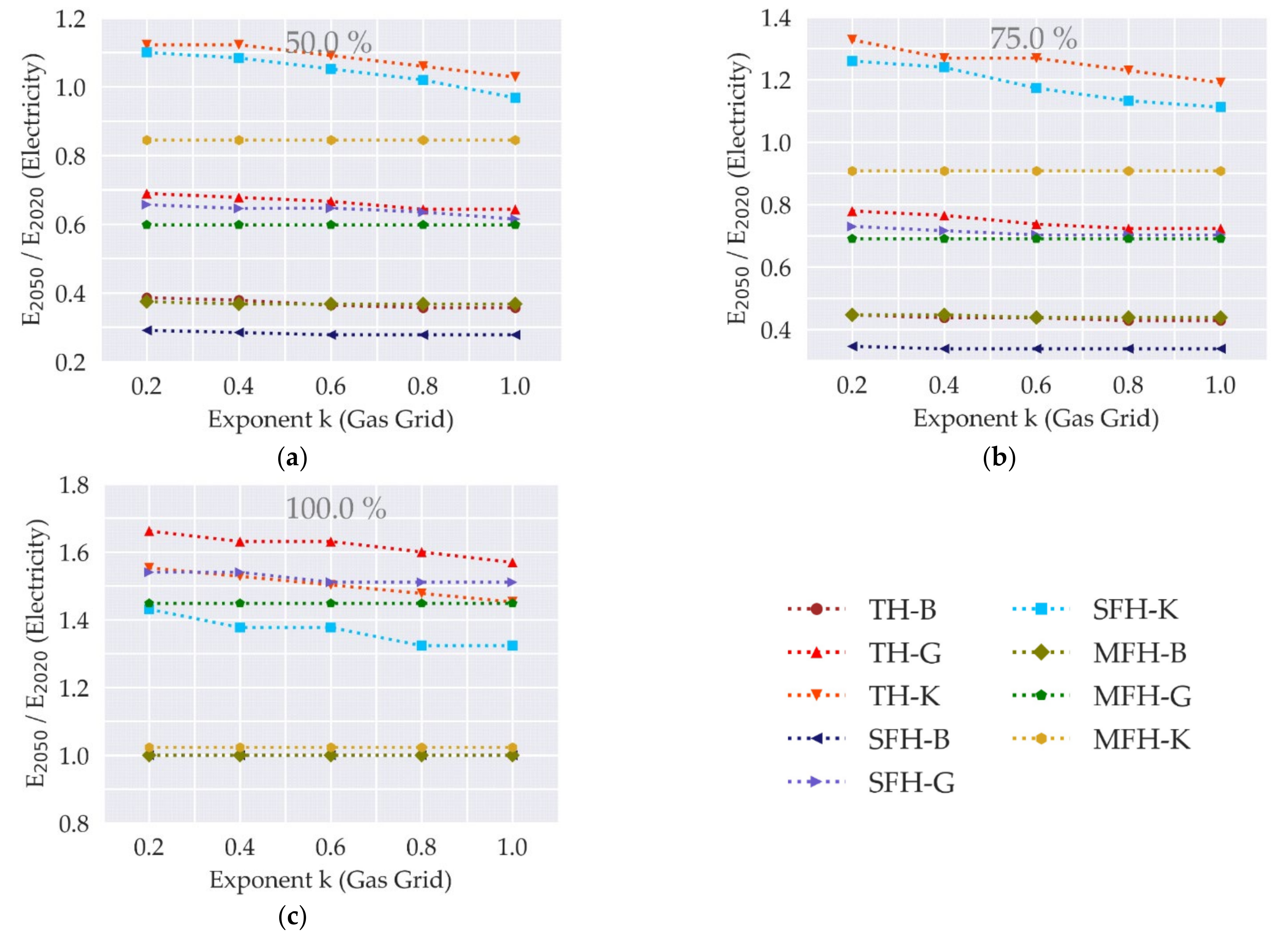
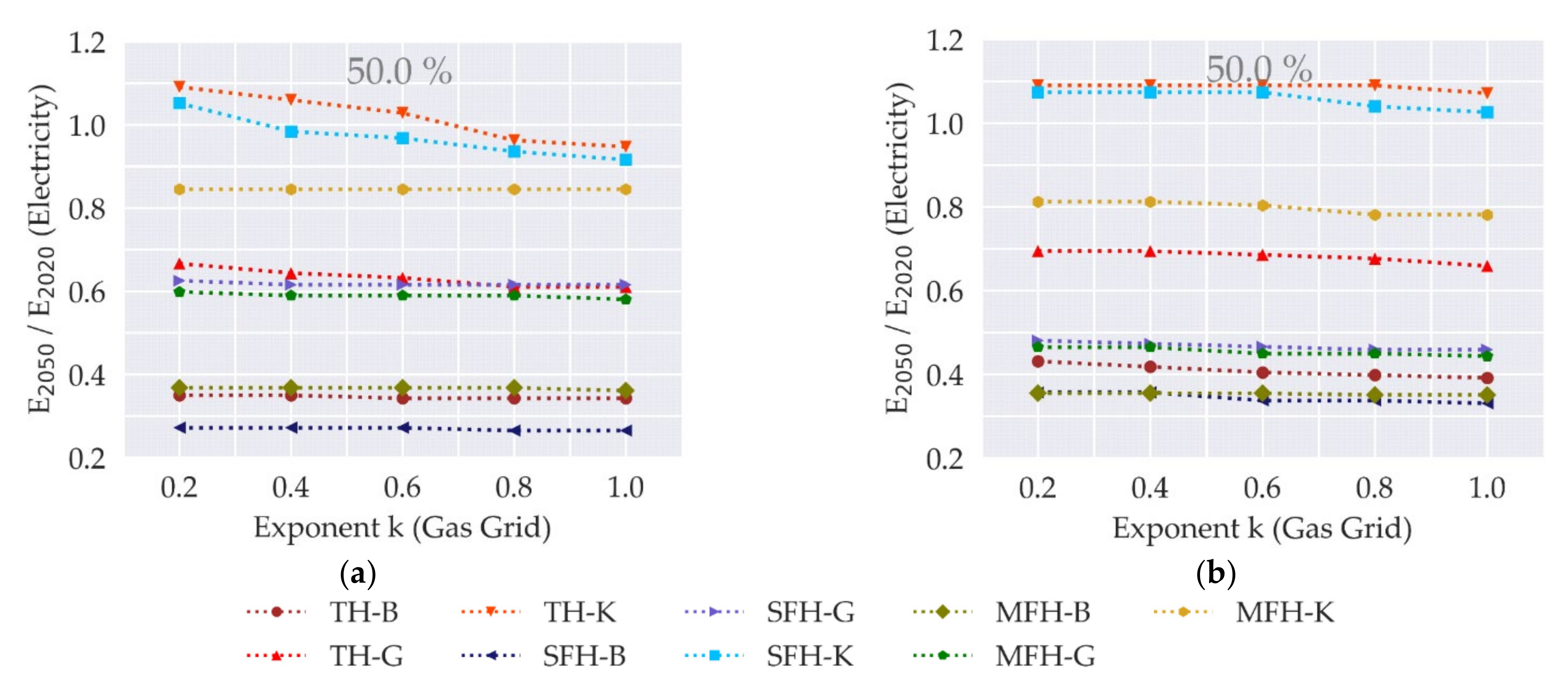
References
- REN21 Renewable Energy Policy Network for the 21st Century. Renewables 2018—Global Status Report; REN21 Renewable Energy Policy Network for the 21st Century: Paris, France, 2018. [Google Scholar]
- Honoré, A. Decarbonisation of Heat in Europe: Implications for Natural Gas Demand; Oxford Institute for Energy Studies: Oxford, UK, 2018. [Google Scholar]
- Speirs, J.; Balcombe, P.; Johnson, E.; Martin, J.; Brandon, N.; Hawkes, A. A greener gas grid: What are the options. Energy Policy 2018, 118, 291–297. [Google Scholar] [CrossRef]
- Qadrdan, M.; Fazeli, R.; Jenkins, N.; Strbac, G.; Sansorn, R. Gas and electricity supply implications of decarbonising heat sector in GB. Energy 2019, 169, 50–60. [Google Scholar] [CrossRef]
- McGlade, C.; Pye, S.; Ekins, P.; Bradshadw, M.; Watson, J. The future role of natural gas in the UK: A bridge to nowhere? Energy Policy 2018, 113, 454–465. [Google Scholar] [CrossRef] [Green Version]
- Jianhong, Y. Analysis of sustainable development of natural gas market in China. Nat. Gas Ind. B 2018, 5, 644–651. [Google Scholar] [CrossRef]
- Ailin, J. Progress and prospects of natural gas development technologies in China. Nat. Gas Ind. B 2018, 5, 547–557. [Google Scholar] [CrossRef]
- Mastorakos, S.; Madrigal, J.; Duffy, E.; Ebertin, M.; Bosso, E. The Future of Natural Gas in the United States; United States Ecologic Institute: Washington, DC, USA, 2017. [Google Scholar]
- Feijoo, F.; Iyer, G.C.; Avraam, C.; Siddiqui, S.A.; Clarke, L.E.; Sankaranarayanan, S.; Binsted, M.T.; Patel, P.L.; Prates, N.C.; Torres-Alfaro, E.; et al. The future of natural gas infrastructure development in the United states. Appl. Energy 2018, 228, 149–166. [Google Scholar] [CrossRef]
- Costello, K.W. Why natural gas has an uncertain future. Electr. J. 2017, 30, 18–22. [Google Scholar] [CrossRef]
- Mac Kinnon, M.A.; Brouwer, J.; Samuelsen, S. The role of natural gas and its infrastructure in mitigating greenhouse gas emissions, improving regional air quality, and renewable resource integration. Prog. Energy Combus. Sci. 2018, 64, 62–92. [Google Scholar] [CrossRef]
- Henning, H.M.; Palzer, A. Energiesystem Deutschland 2050; Fraunhofer-Institut für Solare Energiesysteme (ISE): Freiburg, Germany, 2013. [Google Scholar]
- Gerhardt, N.; Sandau, F.; Scholz, A.; Hahn, H.; Schumacher, P.; Sager, C.; Bergk, F.; Kämper, C.; Knörr, W.; Kräck, J.; et al. Interaktion EE-Strom, Wärme und Verkehr—Analyse der Interaktion Zwischen den Sektoren Strom, Wärme/Kälte und Verkehr in Deutschland in Hinblick auf Steigende Anteile Fluktuierender Erneuerbarer Energien im Strombereich unter Berücksichtigung der Europäischen Entwicklung—Ableitung von Optimalen Strukturellen Entwicklungspfaden für den Verkehrs- und Wärmesektor; Fraunhofer-Institut für Windenergie und Energiesystemtechnik (IWES): Bremerhaven, Germany; Fraunhofer-Institut für Bauphysik (IBP): Stuttgart, Germany; Institut für Energie- und Umweltforschung (IFEU): Heidelberg, Germany; Stiftung Umweltenergierecht: Würzburg, Germany, 2015. [Google Scholar]
- Deutsch, M.; Gerhardt, N.; Sandau, F.; Becker, S.; Scholz, A.; Schumacher, P.; Schmidt, D. Wärmewende 2030— Schlüsseltechnologien zur Erreichung der mittel- und langfristigen Klimaschutzziele im Gebäudesektor; Fraunhofer-Institut für Windenergie und Energiesystemtechnik (IWES): Bremerhaven, Germany; Fraunhofer-Institut für Bauphysik (IBP): Stuttgart, Germany, 2017. [Google Scholar]
- Ziesing, H.J.; Repenning, J.; Emele, L.; Blanck, R.; Böttcher, H.; Dehoust, G.; Förster, H.; Greiner, B.; Harthan, R.; Henneberg, K.; et al. Klimaschutzszenario 2050—2. Endbericht—Eine Studie im Auftrag des Bundesministeriums für Umwelt, Naturschutz, Bau und Reaktorsicherheit; Institut für Angewandte Ökologie e.V. (Öko-Institut): Berlin, Germany; Fraunhofer-Institut für System- und Innovationsforschung (ISI): Karlsruhe, Germany, 2015. [Google Scholar]
- Then, D.; Spalthoff, C.; Bauer, J.; Kneiske, T.M.; Braun, M. Impact of Natural Gas Distribution Network Structure and Operator Strategies on Grid Economy in Face of Decreasing Demand. Energies 2020, 13, 664. [Google Scholar] [CrossRef] [Green Version]
- Däuper, O.; Strasser, T.; Lange, H.; Tischmacher, D.; Fimpel, A.; Kaspers, J.; Koulaxidis, S.; Warg, F.; Baudisch, K.; Bergmann, P.; et al. Wärmewendestudie—Die Wärmewende und Ihre Auswirkungen auf Die Gasverteilnetze; Becker Büttner Held (BBH): Berlin, Germany, 2018. [Google Scholar]
- Sterman, J.D. Business Dynamics—Systems Thinking and Modeling for a Complex World; Irwin McGraw-Hill: Boston, MA, USA, 2000; ISBN 978-0071179898. [Google Scholar]
- Streblow, R.; Ansorge, K. Genetischer Algorithmus zur Kombinatorischen Optimierung von Gebäudehülle und Anlagentechnik—Optimale Sanierungspakete für Ein- und Zweifamilienhäuser—Gebäude-Energiewende Arbeitspapier 7; Institut für Ökologische Wirtschaftsforschung (IÖW): Berlin, Germany; Brandenburgische Technische Universität Cottbus-Senftenberg (BTU CS): Cottbus, Germany; RWTH Aachen|E.ON Energieforschungszentrum, Lehrstuhl für Gebäude- und Raumklimatechnik: Aachen, Germany, 2017. [Google Scholar]
- Pollard, A.; Berg, B. Heat Pump Performance; BRANZ Ltd.: Judgeford, New Zealand, 2018. [Google Scholar]
- Ansorge, K.; Streblow, R. Gebäudesteckbriefe—Exemplarische Sanierungsstrategien für Wohngebäude am Beispiel von Ausgewählten Prototypgebäuden—Gebäude-Energiewende Arbeitspapier 8; Institut für ökologische Wirtschaftsforschung (IÖW): Berlin, Germany; Brandenburgische Technische Universität Cottbus-Senftenberg (BTU CS): Cottbus, Germany; RWTH Aachen | E.ON Energieforschungszentrum, Lehrstuhl für Gebäude- und Raumklimatechnik: Aachen, Germany, 2017. [Google Scholar]
- Then, D.; Hein, P.; Kneiske, T.M.; Braun, M. Analysis of Dependencies between Gas and Electricity Distribution Grid Planning and Building Energy Retrofit Decisions. Sustainability 2020, 12, 5315. [Google Scholar] [CrossRef]
- Kisse, J.M.; Braun, M.; Letzgus, S.; Kneiske, T.M. A GIS-Based Planning Approach for Urban Power and Natural Gas Distribution Grids with Different Heat Pump Scenarios. Energies 2020, 13, 4052. [Google Scholar] [CrossRef]
- Evins, R. A review of computational optimisation methods applied to sustainable building design. Renew. Sustain. Energy Rev. 2013, 22, 230–245. [Google Scholar] [CrossRef]
- Hickey, C.; Deane, P.; McInerney, C.; Gallachóir, B.Ó. Is there a future for the gas network in a low carbon energy system? Energy Policy 2019, 126, 480–493. [Google Scholar] [CrossRef]
- Zeng, Q.; Fang, J.; Li, J.; Chen, Z. Steady-state analysis of the integrated natural gas and electric power system with bi-directional energy conversion. Appl. Energy 2016, 184, 1483–1492. [Google Scholar] [CrossRef]
- Zeng, Q.; Zhang, B.; Fang, J.; Chen, Z. A bi-level programming for multistage co-expansion planning of the integrated gas and electricity system. Appl. Energy 2017, 200, 192–203. [Google Scholar] [CrossRef]
- Unishuay-Vila, C.; Marangon-Lima, J.W.; Zambroni de Souza, A.C.; Perez-Arriaga, I.J.; Balestrassi, P.P. A Model to Long-Term, Multiarea, Multistage, and Integrated Expansion Planning of Electricity and Natural Gas Systems. IEEE Trans. Power Syst. 2010, 25. [Google Scholar] [CrossRef]
- Chaudry, M.; Jenkins, N.; Qadrdan, M.; Wu, J. Combined gas and electricity network expansion planning. Appl. Energy 2014, 113, 1171–1187. [Google Scholar] [CrossRef]
- Hübner, M.; Haubrich, H.-J. Long-Term Pressure-Stage Comprehensive Planning of Natural Gas Networks. In Handbook of Networks in Power Systems II; Sorokin, A., Rebennack, S., Pardalos, P., Iliadis, N.A., Pereira, M.V.F., Eds.; Springer: Berlin/Heidelberg, Germany, 2012; pp. 37–59. ISBN 978-3-642-44612-2. [Google Scholar]
- Von Appen, J. Sizing and Operation of Residential Photovoltaic Systems in Combination with Battery Storage Systems and Heat Pumps; Kassel University Press: Kassel, Germany, 2018; ISBN 978-3-7376-0554-0. [Google Scholar]
- Hittinger, E.; Siddiqui, J. The challenging economics of US residential grid defection. Util. Policy 2017, 45, 27–35. [Google Scholar] [CrossRef]
- Kantamneni, A.; Winkler, R.; Gauchia, L.; Pearce, J.M. Emerging economic viability of grid defection in a northern climate using solar hybrid systems. Energy Policy 2016, 95, 378–389. [Google Scholar] [CrossRef] [Green Version]
- Von Appen, J.; Braun, M. Strategic decision making of distribution network operators and investors in residential photovoltaic battery storage systems. Appl. Energy 2018, 230, 540–550. [Google Scholar] [CrossRef]
- Von Stackelberg, H. Market Structure and Equilibrium; Springer: Berlin/Heidelberg, Germany, 2011; ISBN 978-3-642-12585-0. [Google Scholar]
- Gabriel, S.A.; Conejo, A.J.; Fuller, J.D.; Hobbs, B.F.; Ruiz, C. Complementarity Modeling in Energy Markets, 1st ed.; Hillier, F.S., Price, C.C., Eds.; Springer: New York, NY, USA, 2013; ISBN 978-1-4419-6122-8. [Google Scholar]
- DIN—Deutsches Institut für Normung. DIN EN 12831—Energetische Bewertung von Gebäuden—Verfahren zur Berechnung der Norm-Heizlast; Beuth Verlag: Berlin, Germany, 2017. [Google Scholar]
- Hinz, E. Kosten Energierelevanter Bau- und Anlagenteile bei der Energetischen Modernisierung von Altbauten—Endbericht; Institut Wohnen und Umwelt (IWU): Darmstadt, Germany, 2015. [Google Scholar]
- DIN—Deutsches Institut für Normung. DIN V 18599-1—Energetische Bewertung von Gebäuden—Berechnung des Nutz-, End- und Primärenergiebedarfs für Heizung, Kühlung, Lüftung, Trinkwarmwasser und Beleuchtung; Beuth Verlag: Berlin, Germany, 2016. [Google Scholar]
- DIN—Deutsches Institut für Normung. DIN V 4701-12—Energetische Bewertung heiz- und Raumlufttechnischer Anlagen im Bestand; Beuth Verlag: Berlin, Germany, 2004. [Google Scholar]
- Bundesministerium der Justiz und für Verbraucherschutz; Bundesamt für Justiz. Verordnung über Energiesparenden Wärmeschutz und Energiesparende Anlagentechnik bei Gebäuden (Energieeinsparverordnung—EnEV)—Energieeinsparverordnung vom 24.07.2007; Bundesministerium der Justiz und Verbraucherschutz: Berlin, Germany; Bundesamt für Justiz: Bonn, Germany, 2015. [Google Scholar]
- Hoier, A.; Erhorn, H.; Pfnür, A.; Müller, N. Energetische Gebäudesanierung in Deutschland—Management Summary; Fraunhofer-Institut für Bauphysik (IBP): Stuttgart, Germany; Forschungscenter Betriebliche Immobilienwirtschaft: Darmstadt, Germany; Institut für Wärme und Oeltechnik (IWO): Hamburg, Germany, 2013. [Google Scholar]
- Presse- und Informationsamt der Bundesregierung. CO2-Bepreisung; Die Bundesregierung: Berlin, Germany, 2019; Available online: https://www.bundesregierung.de/breg-de/themen/klimaschutz/co2-bepreisung-1673008 (accessed on 2 May 2020).
- Bundesministerium der Justiz und für Verbraucherschutz; Bundesamt für Justiz. Verordnung über die Entgelte für den Zugang zu Elektrizitätsversorgungsnetzen (Stromnetzentgeltverordnung—StromNEV)—Stromnetzentgeltverordnung vom 25. Juli 2005; Bundesministerium der Justiz und Verbraucherschutz: Berlin, Germany; Bundesamt für Justiz: Bonn, Germany, 2019. [Google Scholar]
- Kreditanstalt für Wiederaufbau (KfW). Energieeffizient Sanieren—Kredit—Kredit für die Komplette Sanierung oder für Einzelne Energetische Maßnahmen; Kreditanstalt für Wiederaufbau (KfW): Frankfurt am Main, Germany, 2020; Available online: https://www.kfw.de/inlandsfoerderung/Privatpersonen/Bestandsimmobilien/Finanzierungsangebote/Energieeffizient-Sanieren-Kredit-(151-152)/ (accessed on 5 May 2020).
- Bundesamt für Wirtschaft und Ausfuhrkontrolle. Förderübersicht Wärmepumpe (Basis-, Innovations- und Zusatzförderung); Bundesamt für Wirtschaft und Ausfuhrkontrolle: Eschborn, Germany, 2018. [Google Scholar]
- Braunstein, L.A.; Cohen, R.; Buldyrev, S.V.; Havlin, S. Optimal Paths in Disordered Complex Networks. Phys. Rev. Lett. 2003, 91, 168701. [Google Scholar] [CrossRef] [PubMed] [Green Version]
- Wang, I.E.; Clandinin, T.R. The Influence of Wiring Economy on Nervous System Evolution. Curr. Biol. 2016, 26, 1101–1108. [Google Scholar] [CrossRef] [Green Version]
- Watts, D.J.; Strogatz, S.H. Collective dynamics of ’small-world’ networks. Nature 1998, 393, 440–442. [Google Scholar] [CrossRef] [PubMed]
- Wen, Q.; Stepanyants, A.; Elston, G.N.; Grosberg, A.Y.; Chklovskii, D.B. Maximization of the connectivity repertoire as a statistical principle governing the shapes of dendritic arbors. Proc. Nat. Acad. Sci. USA 2009, 106, 12536–12541. [Google Scholar] [CrossRef] [PubMed] [Green Version]
- Bisschop, J. AIMMS Optimization Modeling; AIMMS B.V.: Haarlem, The Netherlands, 2019. [Google Scholar]
- The SciPy Community. SciPy Documentation—Scipy.optimize.curve_fit; The SciPy Community, 2019; Available online: https://docs.scipy.org/doc/scipy/reference/generated/scipy.optimize.curve_fit.html (accessed on 29 April 2020).
- Andra, B. CEER Report: Report on Regulatory Frameworks for European Energy Networks; Council of European Energy Regulators: Brussels, Belgium, 2019. [Google Scholar]
- Erdmann, G.; Zweifel, P. Energieökonomik, 2nd ed.; Springer: Berlin/Heidelberg, Germany, 2010; ISBN 978-3-642-12777-9. [Google Scholar]
- Bundesministerium der Justiz und Verbraucherschutz; Bundesamt für Justiz. Gesetz über die Elektrizitäts- und Gasversorgung (Energiewirtschaftsgesetz—EnWG)—Energiewirtschaftsgesetz vom 7. Juli 2005; Bundesministerium der Justiz und Verbraucherschutz: Berlin, Germany; Bundesamt für Justiz: Bonn, Germany, 2019. [Google Scholar]
- Hundt, M. Investitionsplanung unter Unsicheren Einflussgrößen, 1st ed.; Springer Gabler: Wiesbaden, Germany, 2015; ISBN 978-3-658-08337-3. [Google Scholar]
- Loga, T.; Stein, B.; Diefenbach, N.; Born, R. Deutsche Wohngebäudetypologie—Beispielhafte Maßnahmen zur Verbesserung der Energieeffizienz von Typischen Wohngebäuden; Institut Wohnen und Umwelt (IWU): Darmstadt, Germany, 2015. [Google Scholar]
- Statistische Ämter des Bundes und der Länder. Zensus 2011; Statistisches Bundesamt: Wiesbaden, Germany, 2020; Available online: https://ergebnisse.zensus2011.de/?locale=en (accessed on 1 May 2020).
- OpenStreetMap Contributors. Planet Dump Retrieved from https://planet.osm.org; OpenStreetMap Contributors, 2019; Available online: https://wiki.openstreetmap.org/wiki/Researcher_Information (accessed on 29 April 2020).
- Hagberg, A.A.; Schult, D.A.; Swart, P.J. Exploring Network Structure, Dynamics, and Function using NetworkX. In Proceedings of the 7th Python in Science Conference (SciPy 2008), Los Alamos, NM, USA, 1 January 2008; pp. 11–15. [Google Scholar]
- Hart, W.E.; Laird, C.D.; Watson, J.-P.; Woodruff, D.L.; Hackebeil, G.A.; Nicholson, B.L.; Siirola, J.D. Pyomo—Optimization Modeling in Python, 2nd ed.; Springer: New York, NY, USA, 2017; ISBN 978-3-319-58821-2. [Google Scholar]
- Hart, W.E.; Watson, J.-P.; Woodruff, D.L. Pyomo: Modeling and solving mathematical programs in Python. Math. Program. Comput. 2011, 3, 219–260. [Google Scholar] [CrossRef]
- IBM. IBM ILOG CPLEX Optimization Studio; IBM: Armonk, NY, USA, 2020; Available online: https://www.ibm.com/products/ilog-cplex-optimization-studio (accessed on 29 April 2020).
- Thurner, L.; Scheidler, A.; Schafer, F.; Menke, J.-H.; Dollichon, J.; Meier, F.; Meinecke, S.; Braun, M. Pandapower—An Open-Source Python Tool for Convenient Modeling, Analysis, and Optimization of Electric Power Systems. IEEE Trans. Power Syst. 2018, 33, 6510–6521. [Google Scholar] [CrossRef] [Green Version]
- Ingenieurbüro Fischer-Uhrig. STANET Netzberechnung—Für Gas, Wasser, Strom, Fernwärme und Abwasser; Ingenieurbüro Fischer-Uhrig: Berlin, Germany, 2020; Available online: www.stafu.de/de/home.html (accessed on 29 April 2020).
- Lohmeier, D.; Cronbach, D.; Drauz, S.R.; Braun, M.; Kneiske, T.M. Pandapipes: An Open-Source Piping Grid Calculation Package for Multi-Energy Grid Simulations. Sustainability 2020, 12, 9899. [Google Scholar] [CrossRef]
- BMU, Arbeitsgruppe IK III 1. Klimaschutzplan 2050—Klimapolitische Grundsätze und Ziele der Bundesregierung; Bundesministerium für Umwelt, Naturschutz und nukleare Sicherheit (BMU): Berlin, Germany, 2019. [Google Scholar]
- Die Bundesregierung. Gesetzentwurf der Bundesregierung—Entwurf eines Gesetzes zur Vereinheitlichung des Energieeinsparrechts für Gebäude—Gesetz zur Einsparung von Energie und zur Nutzung Erneuerbarer Energien zur Wärme- und Kälteerzeugung in Gebäuden (Gebäudeenergiegesetz—GEG); Die Bundesregierung: Berlin, Germany, 2019. [Google Scholar]
- European Commission. Energy Prices and Costs in Europe; European Commission: Brussels, Belgium, 2019. [Google Scholar]
- Sen, D.; Günay, M.E.; Tunç, K.M.M. Forecasting annual natural gas consumption using socio-economic indicators for making future policies. Energy 2019, 173, 1106–1118. [Google Scholar] [CrossRef]
- Stieß, I.; van der Land, V.; Birzle-Harder, B.; Deffner, J. Handlungsmotive, -Hemmnisse und Zielgruppen für eine Energetische Gebäudesanierung—Ergebnisse einer Standardisierten Befragung von Eigenheimsanierern; Institut für Ökologische Wirtschaftsforschung (IÖW): Berlin, Germany, 2010. [Google Scholar]
- Renz, I.; Hacke, U. Einflussfaktoren auf die Sanierung im Deutschen Wohngebäudebestand—Ergebnisse einer Qualitativen Studie zu Sanierungsanreizen und -Hemmnissen Privater und Institutioneller Eigentümer—Eine Untersuchung im Auftrag der KfW Bankengruppe; Institut Wohnen und Umwelt (IWU): Darmstadt, Germany, 2016. [Google Scholar]
- Institut Wohnen und Umwelt (IWU). TABULA WebTool; Intelligent Energy Europe of the European Union: Brussels, Belgium; Institut Wohnen und Umwelt (IWU): Darmstadt, Germany, 2017; Available online: www.webtool.building-typology.eu/#bm (accessed on 20 May 2020).
- Europäische Union. Verordnung (EU) 2016/679 des Europäischen Parlaments und des Rates zum Schutz natürlicher Personen bei der Verarbeitung personenbezogener Daten, zum freien Datenverkehr und zur Aufhebung der Richtlinie 95/46/EG; Europäische Union: Brussels, Belgium, 2016. [Google Scholar]
- Bothe, D.; Janssen, M.; van der Poel, S.; Eich, T.; Bongers, T.; Kellermann, J.; Lück, L.; Chan, H.; Ahlert, M.; Borrás, C.A.B.; et al. Der Wert der Gasinfrastruktur für die Energiewende in Deutschland—Eine Modellbasierte Analyse—Eine Studie im Auftrag der Vereinigung der Fernleitungsnetzbetreiber (FNB Gas e.V.); Frontier Economics: London, UK; Institut für Elektrische Anlagen und Energiewirtschaft (IAEW): Aachen, Germany; 4Management: Düsseldorf/Cologne, Germany, 2017. [Google Scholar]
- Kusch, W.; Schmidla, T.; Stadler, I. Consequences for district heating and natural gas grids when aiming towards 100% electricity supply with renewables. Energy 2012, 48, 153–159. [Google Scholar] [CrossRef]
- Fritz, S. Economic Assessment of the Long-Term Development of Buildings’ Heat Demand and Grid-Bound Supply; Technische Universität Wien: Vienna, Austria, 2016. [Google Scholar]
- Bundesnetzagentur; Bundeskartellamt. Monitoringbericht 2018; Bundesnetzagentur für Elektrizität, Gas, Telekommunikation, Post und Eisenbahn: Bonn, Germany; Bundeskartellamt: Bonn, Germany, 2019. [Google Scholar]
- Statista. Durchschnittlicher Verbraucherpreis für Leichtes Heizöl in Deutschland in den Jahren 1960 bis 2019; Statistisches Bundesamt: Wiesbaden, Germany; Mineralölwirtschaftsverband (MWW): Berlin, Germany; Energie Informationsdienst: Munich, Germany, 2019; Available online: de.statista.com/statistik/daten/studie/2633/umfrage/entwicklung-des-verbraucherpreises-fuer-leichtes-heizoel-seit-1960/ (accessed on 29 April 2020).
- Statista. Preisentwicklung für Holzpellets in Deutschland in den Jahren 2008 bis 2018; Deutsches Pelletinstitut: Berlin, Germany, 2018; Available online: de.statista.com/statistik/daten/studie/214738/umfrage/preisentwicklung-fuer-holzpellets-in-deutschland/ (accessed on 29 April 2020).
- Bundesministerium der Justiz und Verbraucherschutz; Bundesamt für Justiz. Energiesteuergesetz (EnergieStG)—Energiesteuergesetz vom 15. Juli 2006; Bundesministerium der Justiz und Verbraucherschutz: Berlin, Germany; Bundesamt für Justiz: Bonn, Germany, 2019. [Google Scholar]
- Bundesministerium der Justiz und Verbraucherschutz; Bundesamt für Justiz. Umsatzsteuergesetz (UStG)—Umsatzsteuergesetz in der Fassung der Bekanntmachung vom 21. Februar 2005; Bundesministerium der Justiz und Verbraucherschutz: Berlin, Germany; Bundesamt für Justiz: Bonn, Germany, 2019. [Google Scholar]
- Icha, P. Entwicklung der Spezifischen Kohlendioxid-Emissionen des Deutschen Strommix in den Jahren 1990–2018; Umweltbundesamt: Dessau-Roßlau, Germany, 2019. [Google Scholar]
- Bundesamt für Wirtschaft und Ausfuhrkontrolle. Merkblatt zu den CO2-Faktoren; Bundesamt für Wirtschaft und Ausfuhrkontrolle: Eschborn, Germany, 2019. [Google Scholar]
- Bundesverband der Energie- und Wasserwirtschaft (BDEW). Erdgas—Zahlen, Daten, Fakten; Bundesverband der Energie- und Wasserwirtschaft (BDEW): Berlin, Germany, 2017. [Google Scholar]
- Hartmann, H.; Baumgartner, T.; Lermer, A.; Schön, C.; Kuptz, D. Brennstoffqualität von Holzpellets—Europaweites Holzpelletscreening mit Fokus auf den Deutschen Pelletmarkt; Technologie- und Förderzentrum im Kompetenzzentrum für Nachwachsende Rohstoffe: Straubing, Germany, 2015. [Google Scholar]
- Bundesministerium der Justiz und Verbraucherschutz; Bundesamt für Justiz. Verordnung über die Anreizregulierung der Energieversorgungsnetze (Anreizregulierungsverordnung—ARegV)—Anreizregulierungsverordnung vom 29. Oktober 2007; Bundesministerium der Justiz und Verbraucherschutz: Berlin, Germany; Bundesamt für Justiz: Bonn, Germany, 2019. [Google Scholar]
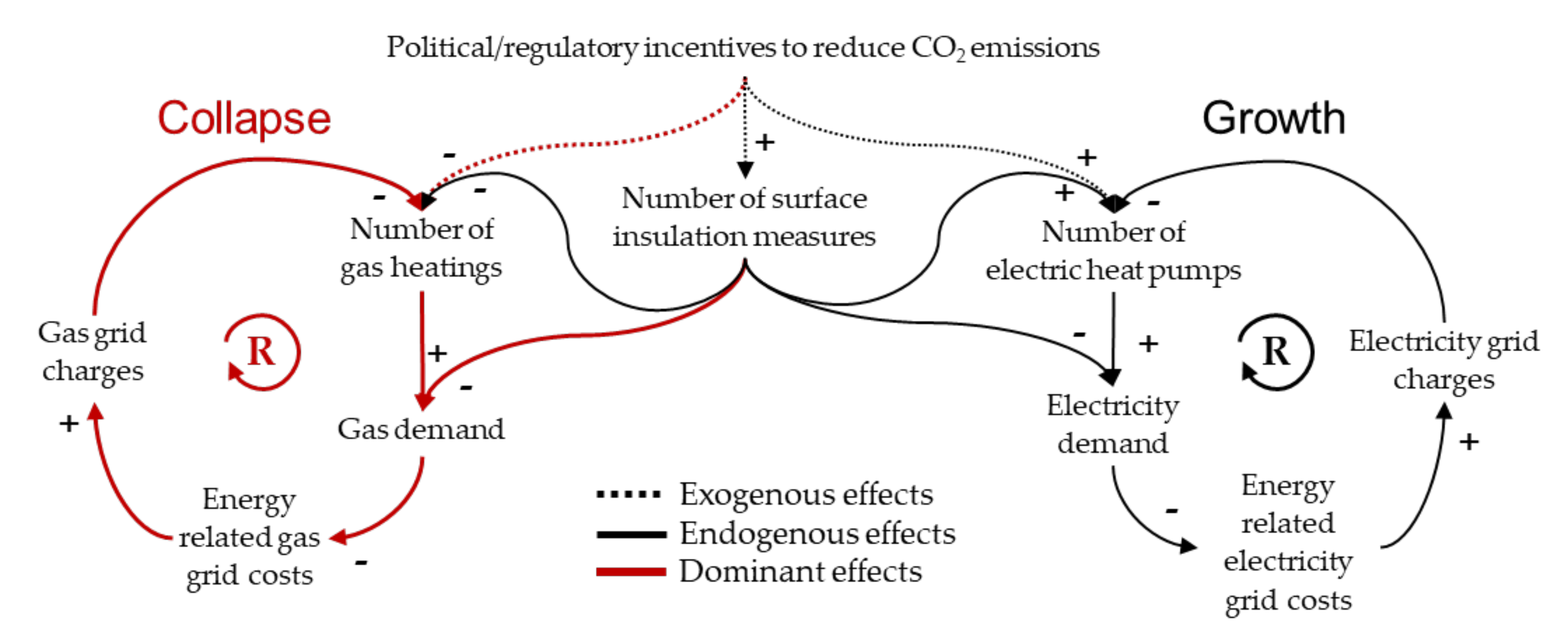
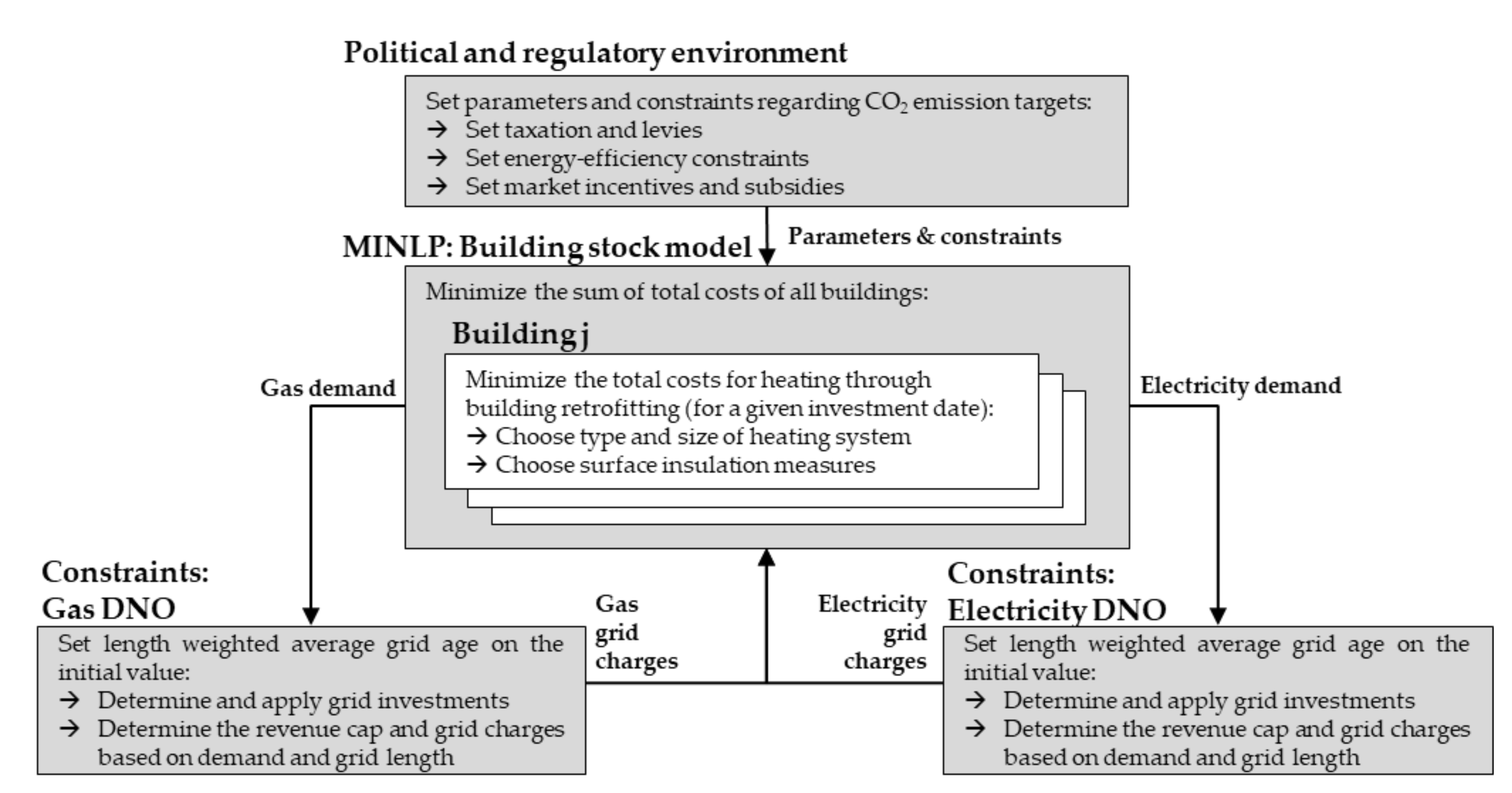

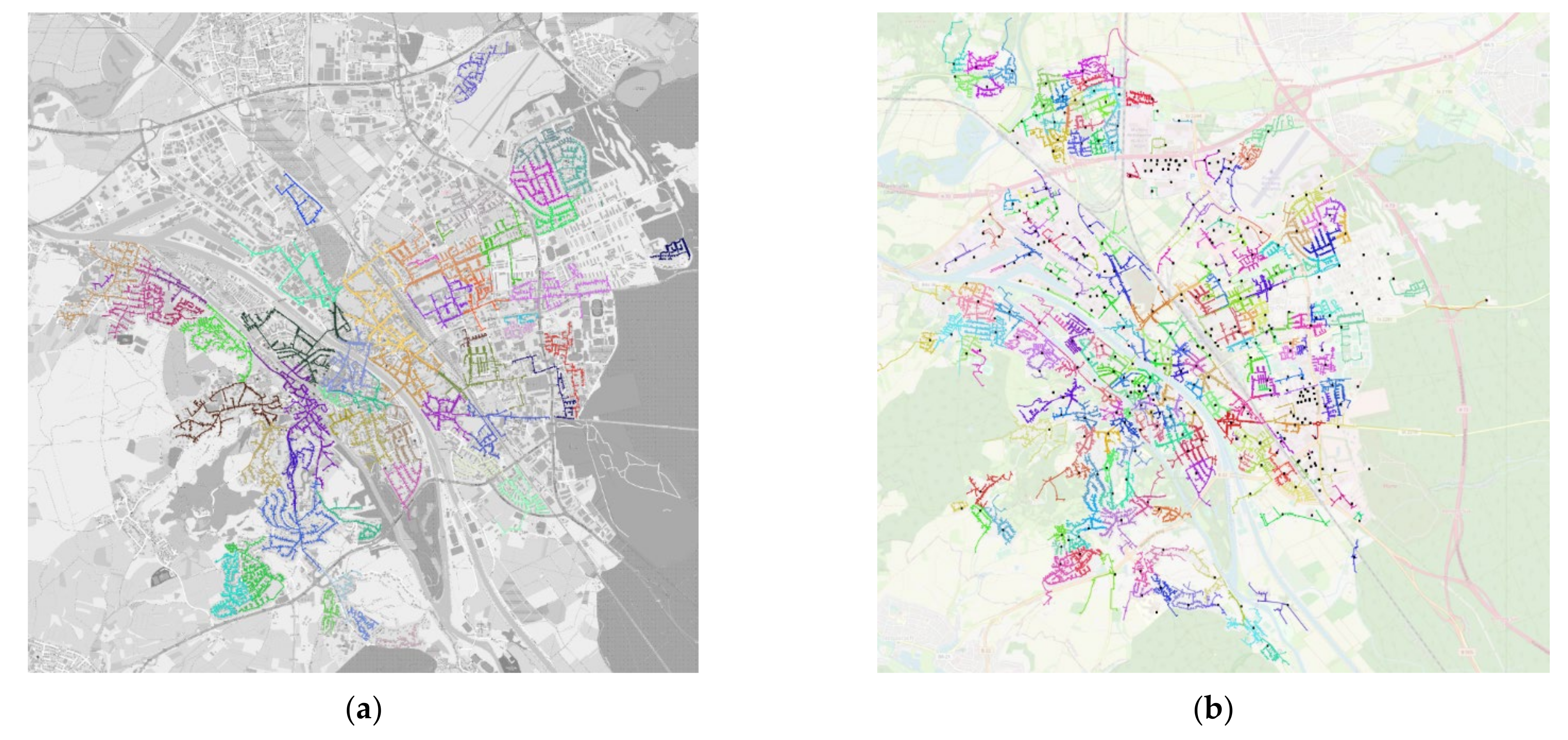
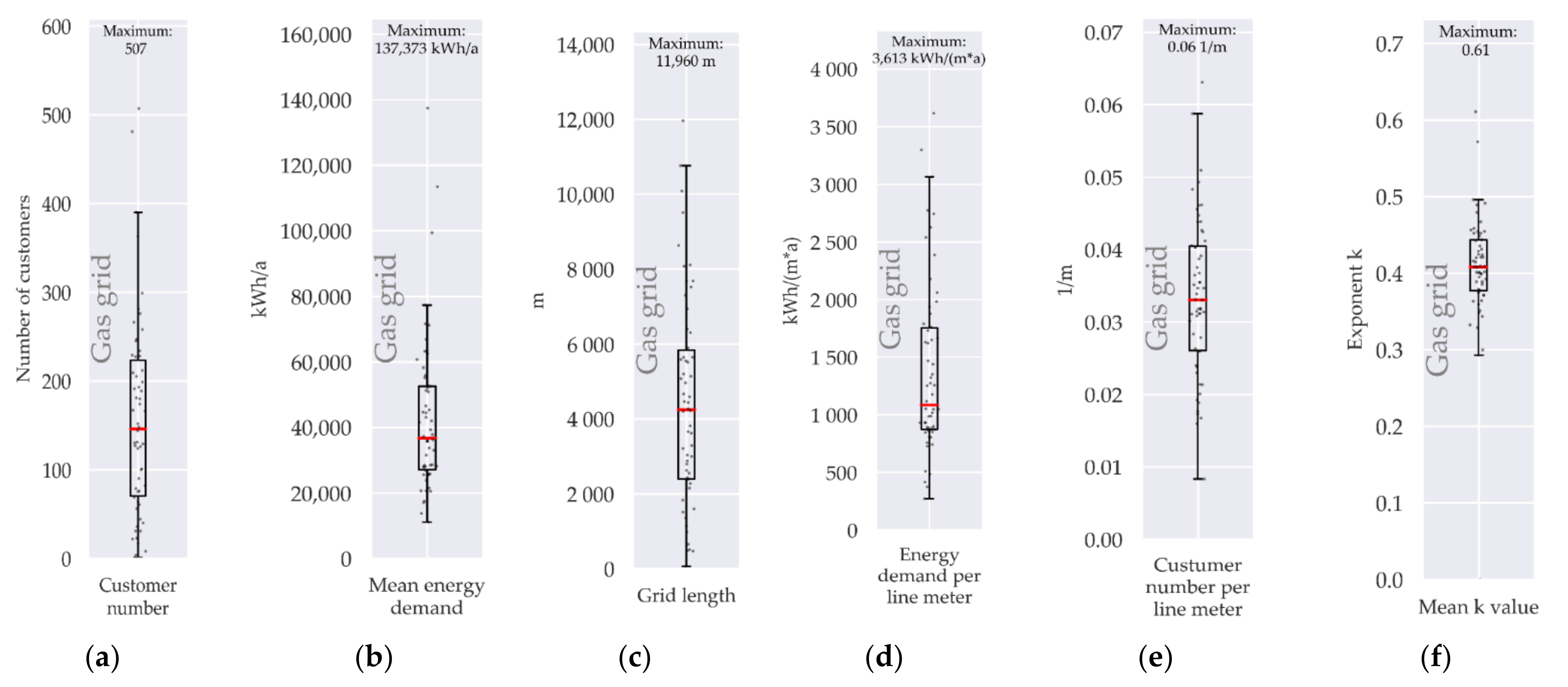

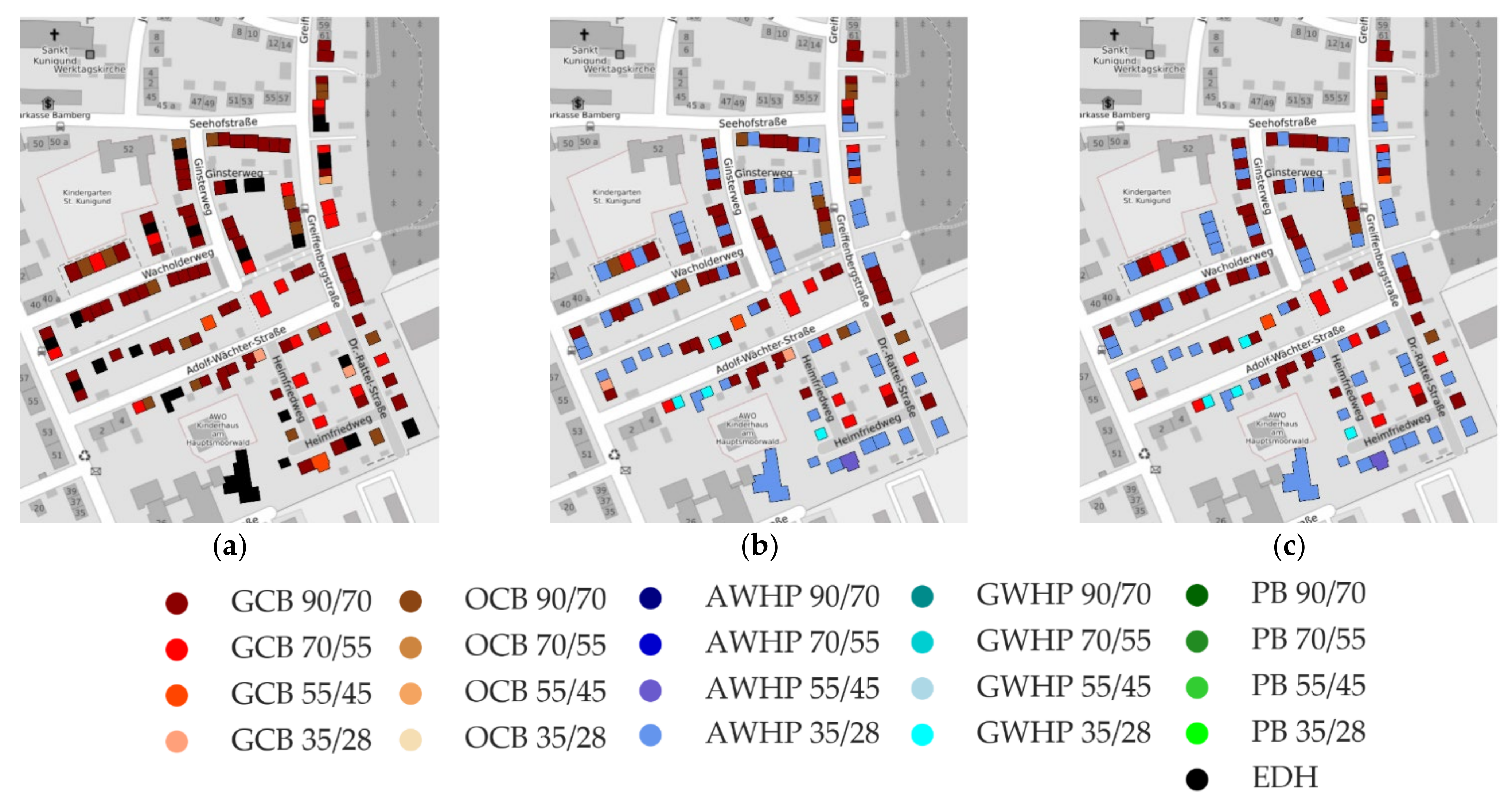
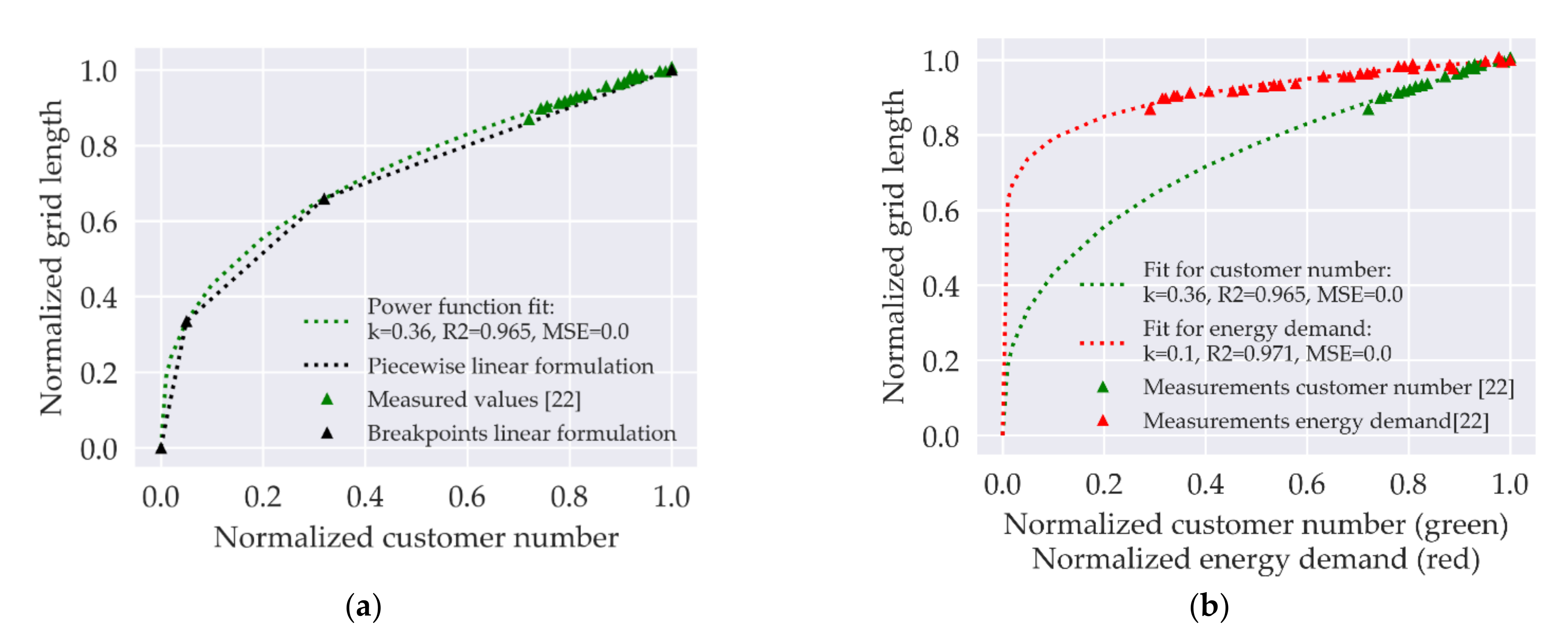
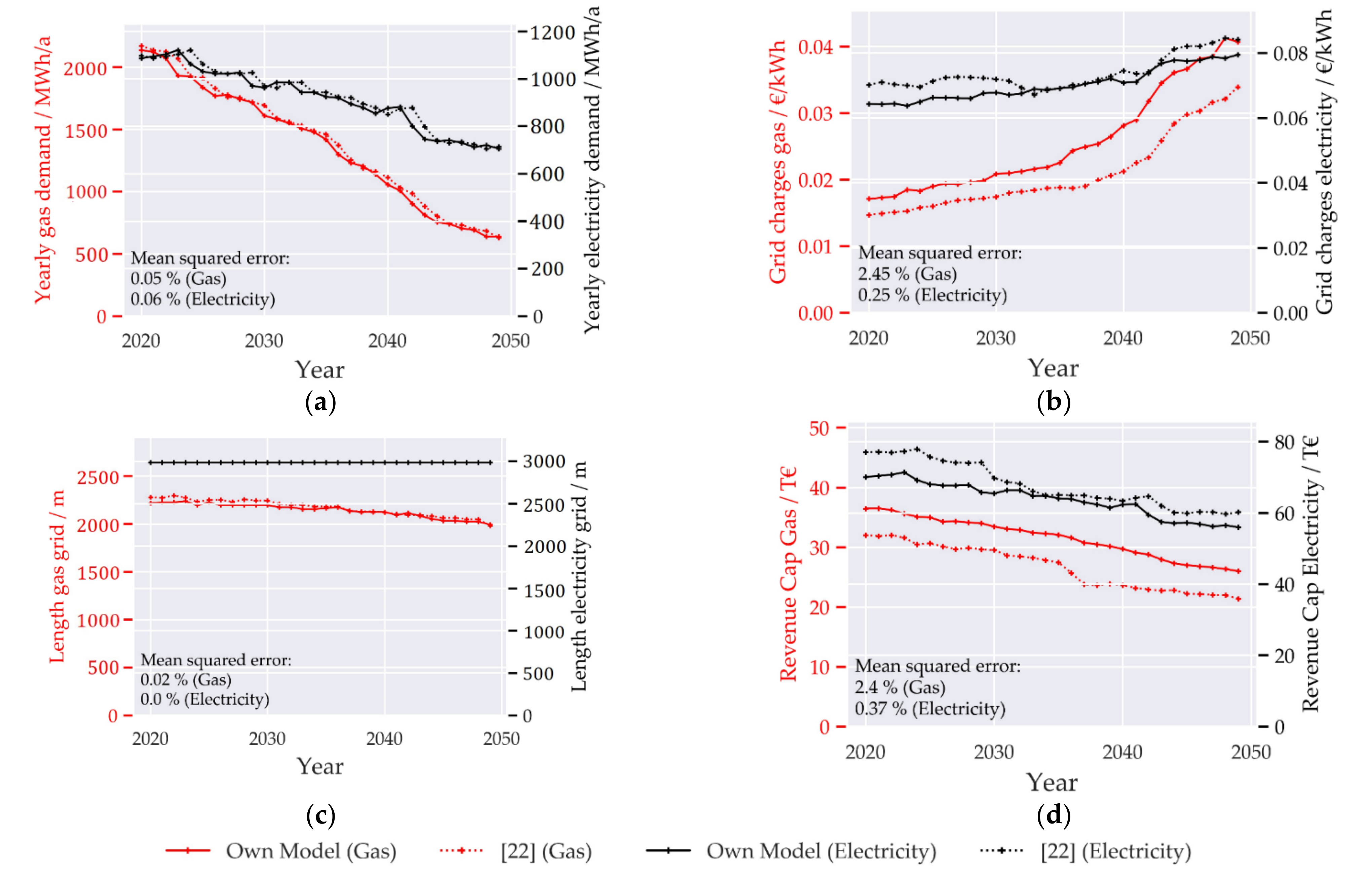



| Cost Component | Considered Dependencies | Share of Cost Base in Bamberg * (%) | ||||
|---|---|---|---|---|---|---|
| Gas DNO | Electricity DNO | |||||
| CAPEX | Calculatory return equity | + | - | 9.9 | 5.1 | |
| Calculatory trade tax | + | - | 1.3 | 0.7 | ||
| Interest on borrowed capital | + | - | 6.6 | 3.9 | ||
| Calculatory depreciations | + | - | 15.0 | 10.3 | ||
| OPEX | Other operational costs | + | 33.6 | 29.8 | ||
| + | 0.0 | 1.6 | ||||
| + | 19.0 | 34.1 | ||||
| + | 14.7 | 14.7 | ||||
| Building Types | TH, SFH, MFH | |||||||||
|---|---|---|---|---|---|---|---|---|---|---|
| Buildings per line meter (L/m) | 0.04 | |||||||||
| Connection ratio gas grid (L/m) | 1 | 0.75 | 0.5 | |||||||
| Gas customers per line meter (L/m) | 0.04 | 0.03 | 0.02 | |||||||
| Building age classes | B | G | K | B | G | K | B | G | K | |
| Initial heating system (Share of systems in the building collective) * | AWHP | 0.00 | 0.00 | 0.00 | 0.00 | 0.00 | 0.23 | 0.00 | 0.00 | 0.48 |
| GCB | 1.00 | 1.00 | 1.00 | 0.74 | 0.74 | 0.77 | 0.52 | 0.52 | 0.52 | |
| OCB | 0.00 | 0.00 | 0.00 | 0.10 | 0.10 | 0.00 | 0.26 | 0.26 | 0.00 | |
| PB | 0.00 | 0.00 | 0.00 | 0.00 | 0.00 | 0.00 | 0.00 | 0.00 | 0.00 | |
| EDH | 0.00 | 0.00 | 0.00 | 0.16 | 0.16 | 0.00 | 0.23 | 0.23 | 0.00 | |
| Heating circuit temperature (forward and return flow in °C) | 90/70 | 70/55 | 35/28 | 90/70 | 70/55 | 35/28 | 90/70 | 70/55 | 35/28 | |
| Influencing Factor/Actor | Subtypes, Definition, and Literature Used for Scenario Generation, Parameter Variation | Consideration in Sensitivity Analysis (Objective Variable, Scenarios, Input Parameter) |
|---|---|---|
| State regulatory environment/policy (grid regulation see DNO) | - Taxation and levy systems: e.g., trade tax, CO2 tax, CHP, or renewable resources levy [43,67]. - Energy efficiency constraints for the building heating system or the surface [41,67,68]. - State market incentive and subsidy programs: e.g., for energy-efficiency measures in heating and building retrofit sector [45,46]. | - Objective variable: ---- - Scenarios: One scenario considering the situation in Germany [22] - Sensitivity parameter: ---- |
| Grid charge models/policy | - Energy and/or power-based grid charges or other models [31]. - Exceptions for systemically important facilities: e.g., reduced grid charges for interruptible loads [44]. | - Objective variable: Relative grid charges - Scenarios: One scenario with yearly energy-based grid charges - Sensitivity parameter: ---- |
| Market, technology, and environmental conditions | - Increased efficiency of existing or new systems: e.g., the COP of electrical heat pumps [20]. - Fluctuations of system or energy carrier prices: e.g., CO2 footprint of the used energy carrier [69]. - Climate and weather conditions in the grid area. | - Objective variable: ---- - Scenarios: One scenario considering the situation in Germany [22] - Sensitivity parameter: ---- |
| Building, use, and ownership characteristics/building | - Building usage type and socioeconomic characteristics of the owner [70,71]. - Building age class and insulation status of the surface [57]. - Technical building equipment options including the heating system [72]. - Decentralized energy generation: e.g., solar thermal, PV, or CHP systems [34]. | - Objective variable: Relative cumulated yearly energy demand - Scenarios: Various residential-type building collectives with different demand and customer densities [73]; variation of the interest rate on energy procurement - Sensitivity parameter: ---- |
| DNO and grid characteristics/DNO | - The age of the total fixed assets of the grid [17]. - Grid topology: relationship between the customer number and the grid length [16]. - Cost allocation (CAPEX and OPEX) of the DNO [17]. - Strategy of the DNO [17,22]. - Design of the regulatory mechanisms: e.g., depreciation periods, cost, or price-based regulation, quality benchmarking [17,53]. | - Objective variable: ---- - Scenarios: Two grid age scenarios, where the DNO’s strategy is to maintain the grid age on a stable level - Sensitivity parameter: Various topology configurations |
Publisher’s Note: MDPI stays neutral with regard to jurisdictional claims in published maps and institutional affiliations. |
© 2021 by the authors. Licensee MDPI, Basel, Switzerland. This article is an open access article distributed under the terms and conditions of the Creative Commons Attribution (CC BY) license (http://creativecommons.org/licenses/by/4.0/).
Share and Cite
Then, D.; Bauer, J.; Kneiske, T.M.; Braun, M. Interdependencies of Infrastructure Investment Decisions in Multi-Energy Systems—A Sensitivity Analysis for Urban Residential Areas. Smart Cities 2021, 4, 112-145. https://0-doi-org.brum.beds.ac.uk/10.3390/smartcities4010007
Then D, Bauer J, Kneiske TM, Braun M. Interdependencies of Infrastructure Investment Decisions in Multi-Energy Systems—A Sensitivity Analysis for Urban Residential Areas. Smart Cities. 2021; 4(1):112-145. https://0-doi-org.brum.beds.ac.uk/10.3390/smartcities4010007
Chicago/Turabian StyleThen, Daniel, Johannes Bauer, Tanja M. Kneiske, and Martin Braun. 2021. "Interdependencies of Infrastructure Investment Decisions in Multi-Energy Systems—A Sensitivity Analysis for Urban Residential Areas" Smart Cities 4, no. 1: 112-145. https://0-doi-org.brum.beds.ac.uk/10.3390/smartcities4010007





